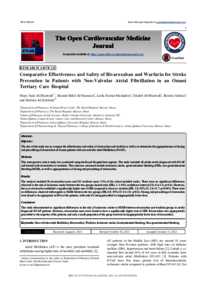Document
Comparative effectiveness and safety of rivaroxaban and warfarin for stroke prevention in patients with non-valvular atrial fibrillation in an Omani tertiary care hospital.
Identifier
DOI: 10.2174/18741924-v16-e2202281
Source
Open Cardiovascular Medicine Journal. v. 16, 1, e187419242202281
Contributors
Al-Naamani, Hamed Hilal., Author
Mokadem, Leila Neshat., Author
Al-Maawali, Ghalib., Author
Salman, Bushra., Author
Al-Zakwani, Ibrahim., Author
Country
United Arab Emirates.
Publisher
Bentham Science Publishers.
Gregorian
2022-01-01
Language
English
Subject
English abstract
Objective: The aim of the study was to compare the effectiveness and safety of rivaroxaban and warfarin as well as to determine the appropriateness of dosing and prescribing of rivaroxaban in Omani patients with non-valvular atrial fibrillation (NVAF). Methods: This retrospective cohort study was conducted using the Royal Hospital data registry. The study included all adults newly diagnosed with NVAF and treated with rivaroxaban or warfarin. The outcomes measured include ischaemic stroke, gastrointestinal bleeding (GIB), non-gastrointestinal bleeding (NGIB), as well as appropriateness of dosing and prescribing of rivaroxaban. Results: The analysis included 96 rivaroxaban users and 183 warfarin users; 51% of the cohort included males. There were no significant differences observed in the risk of ischaemic stroke between the two groups (hazard ratio (HR), 1.1; 95% confidence interval (CI): 0.4-3.4; p=0.8). However, those on rivaroxaban exhibited a significantly higher rate of GIB compared to those on warfarin (HR, 5.9; 95% CI: 2.9-11.7; p=0.001). There were no differences observed with regards to NGIB between the two groups (HR, 0.9; 95% CI: 0.4-1.9; p=0.8). Dosing and prescribing of rivaroxaban were found to be appropriate in 89% of the patients, with only 6% being prescribed an inappropriately lower dose. Conclusion: The study demonstrated no significant differences in the risk of ischaemic stroke or NGIB between rivaroxaban and warfarin groups in newly diagnosed NVAF patients. However, rivaroxaban users were found to have a significantly higher risk of GIB. Rivaroxaban was appropriately prescribed to the majority of the patients, and only a small proportion of the group received an inappropriately lower dose of rivaroxaban.
ISSN
1874-1924
Category
Journal articles

